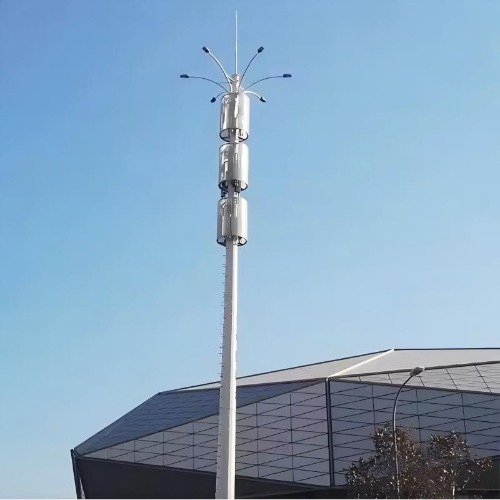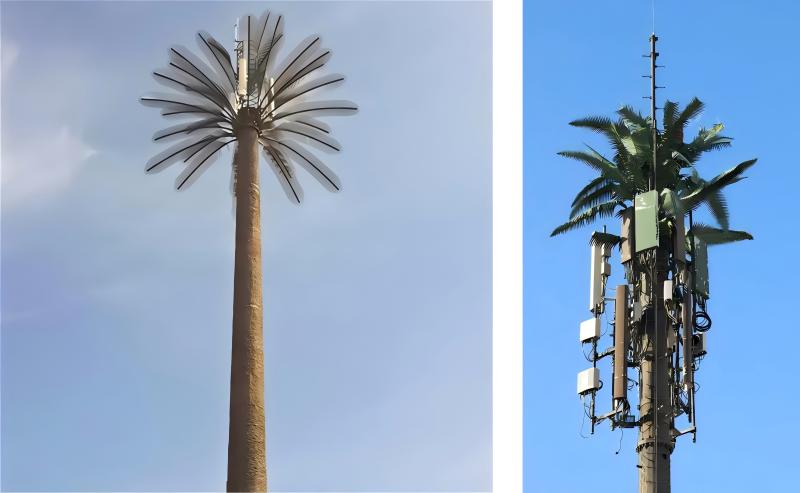Definition: Structural towers engineered to visually blend with surroundings while maintaining full functionality.
Core Objectives:
Minimize visual intrusion in sensitive areas (residential, historic, scenic)
Reduce vandalism/theft risk in remote locations
Conceal critical infrastructure (military/security)
Meet strict zoning/regulatory requirements
Key Engineering Principles:
Spectrum Matching: Replicate surrounding reflectance across visible, IR & radar bands
Texture Replication: Mimic surface granularity (bark, concrete, foliage)
Form Disruption: Break recognisable tower silhouettes
Material Adaptation: Use non-reflective, radar-absorbing composites

| Subtype | Technical Specifications | Applications |
|---|---|---|
| Forest Towers | - Glass-reinforced polymer (GRP) bark-textured cladding - Antenna mounts disguised as tree branches - Custom color matching using RAL K7 woodland palette |
Cellular networks in national parks Wildlife observation posts |
| Rockface Towers | - Geopolymer concrete with embedded local aggregates - Non-reflective angled facets (10°–45°) - Radar-diffusing surface treatments |
Mountainous telecom sites Border surveillance |
| Desert Towers | - Sand-textured polyurethane coating (RAL 1019) - Heat-dissipating vent designs mimicking dunes - UV-stable materials resisting 50+°C temps |
Oil field communications Military desert ops |
| Subtype | Technical Specifications | Applications |
|---|---|---|
| Stealth Steeple | - Church spire profile with internal lattice structure - Bell tower acoustic dampening for equipment noise - Lead-coated copper exterior (patina aged) |
Historic district 5G deployment |
| Monopalm Trees | - FRP trunk with polyethylene fronds (wind rating 130km/h) - Internal stainless steel reinforcement spine - Rain gutter systems disguised as vines |
Resort area telecom High-end residential |
| Vent Stack Towers | - Double-walled chimney design with thermal baffles - Industrial-grade powder coating (RAL 7022) - Emissions-compliant heat dissipation |
Factory complexes Port authority systems |

| Subtype | Technical Specifications | Applications |
|---|---|---|
| Flagpole Towers | - Telescoping aluminum sections (max 40m) - Internal waveguide antenna feeds - Halyard pulley system integration |
Embassies & government compounds Urban microcells |
| Water Tower Replicas | - Pressurized FRP tank shell (holds 20,000L) - Structural lattice inside tank cavity - Functional water level indicators |
Municipal infrastructure Rural water districts |
| Billboard Towers | - Digital display mounting structure - Cable raceways behind ad panels - 360° service catwalks |
Highway telecom Urban advertising |
(Note: Declassified tech only)
| Subtype | Technical Specifications | Applications |
|---|---|---|
| RF-Stealth Masts | - Carbon fiber composites with radar-absorbent mats (RAM) - Reduced RCS profile (<0.1 m² at X-band) - IR-suppressing thermal wraps |
Forward operating bases ELINT stations |
| Rapid-Deploy Scrim | - Modular camo netting with spectral signature control - Lightweight tensioned membrane (3kg/m²) - Multi-band frequency selective surfaces (FSS) |
Mobile artillery radar Temporary surveillance |
| False Structures | - Inflatable decoy towers with corner reflectors - Heat signature emulators - EMI-shielded equipment pods |
Electronic warfare deception Force protection |
Material Science:
Coatings: Ceramic-loaded epoxy with chameleon pigments (shift with viewing angle)
Texturing: Laser-etched mold replication of natural surfaces (±0.02mm accuracy)
Thermal Management: Phase-change materials (PCM) in cladding to mask heat signatures
Electromagnetic Engineering:
Frequency Selective Surfaces (FSS): Transparent to operational bands (e.g., 1.7–2.5 GHz) while blocking others
Radar-Absorbing Structures (RAS): Carbon nanotube-doped composites attenuating 8–18 GHz
Structural Integration:
Wind load preservation: Camo elements engineered for ≤5% additional drag
Maintenance access: Hidden hatches with biometric security
Lightning protection: Dissipative strips embedded in artificial bark

| Camouflage Type | Visual Detection Range | Radar Cross Section | Maintenance Cycle | Cost Premium |
|---|---|---|---|---|
| Forest Blending | ≤100m | Baseline | 18 months | 25–40% |
| Urban Stealth | ≤50m | +0.5 dBsm | 24 months | 35–60% |
| Military RF-Stealth | ≤30m | -20 dBsm | 6 months | 200–400% |
| Architectural Mimic | ≤15m | +3 dBsm | 60 months | 70–90% |
Site Analysis Phase
LiDAR scanning of surroundings
Spectral reflectance mapping (350–2500nm)
Historic visibility studies (seasonal variations)
Regulatory Compliance
FAA obstacle marking exemptions
Local heritage preservation codes
Military security clearance requirements
Lifecycle Considerations
UV degradation testing (3000+ hour accelerated weathering)
Vandalism resistance (IK10 impact rating)
Fire safety (Class A flame spread rating)
Case Study: Singapore's "Trees of Knowledge" project deployed 132 monopalm towers in Marina Bay, reducing visual impact complaints by 92% while delivering 5G coverage. Each "tree" contains 18 antennas with <0.5dB signal loss through FRP cladding.
Learn more at www.alttower.com